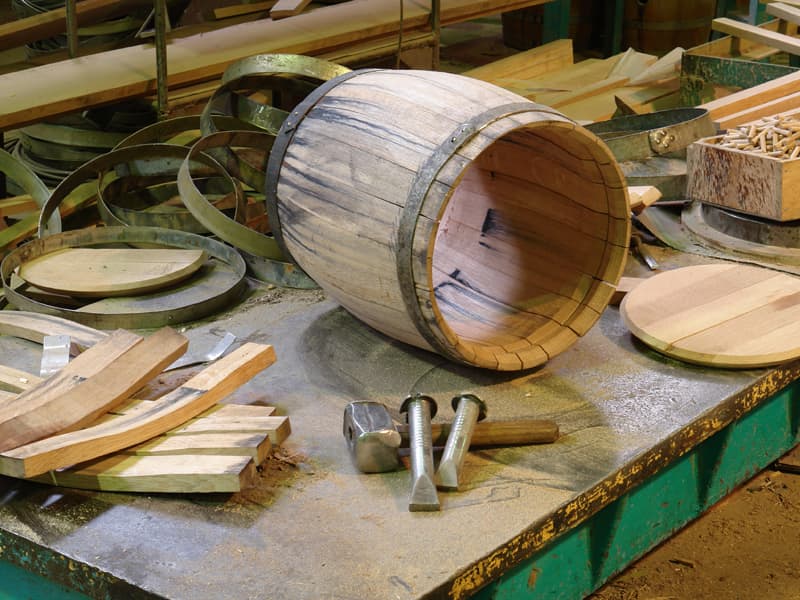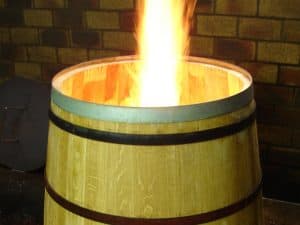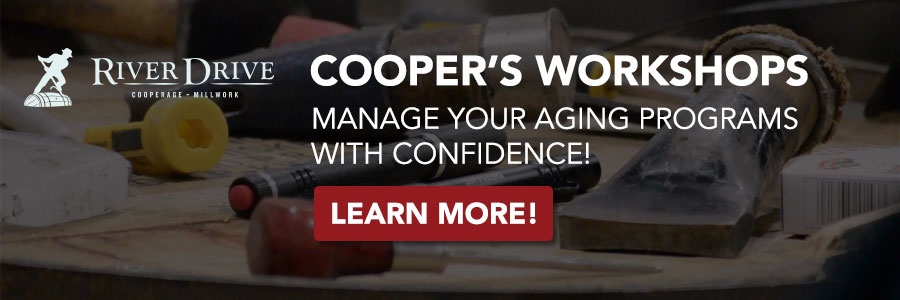On the surface, making an oak barrel is simple woodworking. While a cooper’s joinery skills have to be impeccable to create the curving elegant shape, each stave patiently beveled, tapered and bent to fit its neighbor seamlessly, oak barrel makers also have to simultaneously navigate the fringes of boatbuilding and the ephemeral world of flavor. For the spirit cask isn’t just a container, but, a watertight, integral element in making wine, beer and liquor.

Types of Coopers
Coopers do make other containers, as well. The “slack” cooper traditionally made casks to hold dry goods of all sorts, made from softwoods and of very low quality. The “white” cooper made watertight vessels like buckets and tubs, requiring more skill and better materials. But, it is the “tight” cooper who makes watertight barrels, and whose process we’ll look at a bit closer:
Oak Barrel Wood
White oak is the only material used to make an oak barrel, the only species of wood to address all areas of interest for the cooper. It’s an obvious choice for strength, but white oak is also rot-resistant; its closed-cell structure prevents water from moving laterally through its pores. Lastly, white oak adds good flavors to its liquid contents, unlike most other potential wood options.
Logs must be quarter-sawn, both to maximize the strength of the staves (remember, when full, a standard 53-gallon barrel can weigh more than 400 pounds!) and to orient the wood rings and rays so as to better retain liquid. Then the boards are stacked and left to dry outside in the elements for a minimum of a year, sometimes as much as three years for wine barrels! This painfully long “seasoning” helps to mellow out harsh flavors in the freshly cut oak.
The Oak Barrel Making Process
Now, once the oak is ready, the cooper begins shaping the staves, curving them on one face, and cupping the opposing one. The staves are then tapered end to end, and beveled along their edges. Note that each stave is a random width, and therefore its bevels are custom, relative to its portion of the “pie wedge.” Suitably joined, the staves are gathered together in hoops at one end with the others splayed apart in what the cooper calls a “rose.”
 Now how to get them together at the other end? This is the real magic of the cooperage. The “rose” is heated gently over steam heat or fire and regularly blasted with water, softening the lignin in the oak. Slowly the splayed stave ends are winched together, bending in concert to form the iconic bulge of the barrel. With the shape substantially completed, the cooper now further toasts the white oak over a fire, which caramelizes sugars in the wood, as well as creating a layer of “charr” on the interior. Here is where the cooper plays with flavor, imparting different elements depending on the intensity and duration of the oak barrel toasting, bringing out layers of vanilla, pepper, smoke, and chocolate.
Now how to get them together at the other end? This is the real magic of the cooperage. The “rose” is heated gently over steam heat or fire and regularly blasted with water, softening the lignin in the oak. Slowly the splayed stave ends are winched together, bending in concert to form the iconic bulge of the barrel. With the shape substantially completed, the cooper now further toasts the white oak over a fire, which caramelizes sugars in the wood, as well as creating a layer of “charr” on the interior. Here is where the cooper plays with flavor, imparting different elements depending on the intensity and duration of the oak barrel toasting, bringing out layers of vanilla, pepper, smoke, and chocolate.
With a bit more acrobatics, the cooper fits “heads”, or the top and bottom, into the cask by first cutting a fine “croze” or groove around each end. The heads are then beveled and fit into the croze, and the hoops that contain the barrel are driven down, tightening up the whole work. Like the ringing of the blacksmith’s anvil, the cooper’s “tap, tap, tap,” tightening his hoops is a constant din around the shop.
The Final Product
If the joinery is good, the white oak is sound, properly seasoned and toasted, and the hoops are strong and driven tight, when wetted the staves will swell up a bit and press together and squeeze the head, resulting in a tight oak barrel suitable for spirits of all kinds. All in a day’s work for the cooper.


